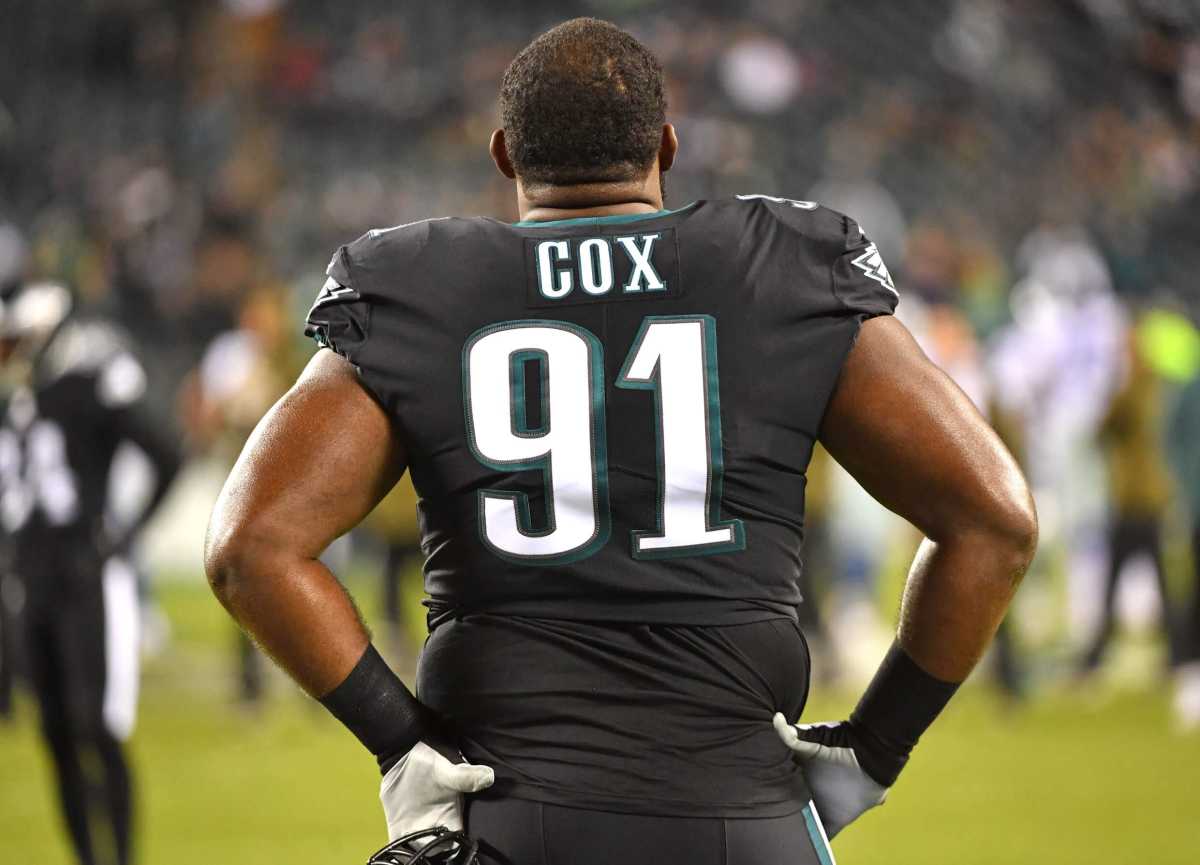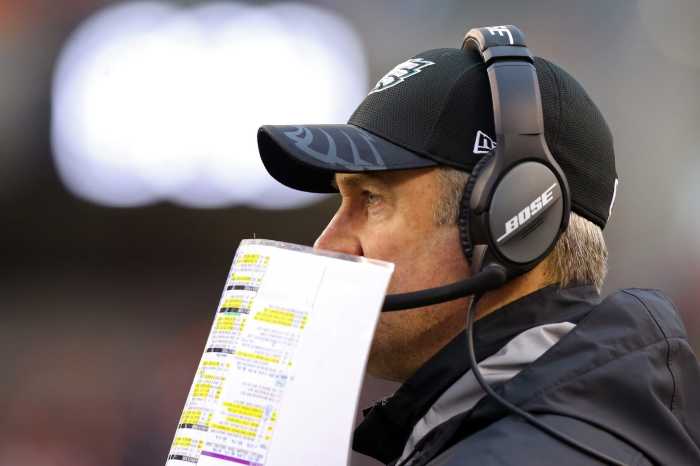The Philadelphia Eagles face an uphill battle this afternoon facing the red-hot New Orleans Saints at home in a game that could decide the rest of the season for the Birds. There will be many intriguing match ups to keep an eye on heading into the NFC showdown that features some of the top play makers in the league. Our fearless leader Liam Jenkins outlined five key positional battles for the Eagles if they are to pull out the upset.
Five matchups the Eagles need to win if they are to overthrow the Saints on Sunday
One of the showdowns that has been mentioned by multiple Eagles’ writers is that between the Saints’ impressive offensive line and the Eagles’ defensive line that hasn’t quite lived up to the hype. Notably hampered by injuries, the defensive lineman haven’t been able to impose their will on offenses the way they were able to during last year’s Super Bowl run. They will face a tough test against a Saints’ front line that has allowed a league-low nine sacks through as many games. As a writer, you love it when players spell out the keys to the game for you, and Fletcher Cox did just that in a snippet from his interview this week:
“They’re not taking a lot of sacks. [Brees] is getting rid of the ball fast, but there’s going to come a time where he’s going to have to hold the ball. We have to create those situations [by limiting them] on first and second down.”
Specifically, Drew Brees has been getting rid of the football in 2.41 seconds on average, fourth quickest in the league. This has been especially handy on first downs, on which Brees leads the league with a 128.2 passer rating. The Saints facilitate this by moving players around and making it difficult for defenses to predict what they are doing. You’ll see in the video below, appearing to be in a 13 personnel formation — habitually a heavy running set — they then motion into a trips formation. This allows Drew Brees to recognize zone coverage, and forces a linebacker to follow Michael Thomas downfield.
Drew Brees is completing nearly 80% of his passes on 1st Down this season and @GregCosell shows you how the @Saints use personnel, formations and basic pass game concepts to be incredibly efficient.#GoSaints #SeizeTheDEY #NOvsCIN pic.twitter.com/xviBtVFN7F
— NFL Matchup on ESPN (@NFLMatchup) November 9, 2018
Trips formation is not uncommon for New Orleans. In fact, they rank 11th in the NFL with 6.3 yards per play in said formation. They are also highly efficient in empty sets: 9.4 yards per play, first in the league. This formation can also be deceptive as they will often line up in a single-back look and motion running backs Mark Ingram and Alvin Kamara out of the backfield.
Why is this relevant, you ask. Empty and trips formations tend to indicate that the offence will only have five designated pass blockers. It also forces defenses to play smaller nickel and dime packages, leaving four and sometimes three down lineman. On the plus side, no six or seven man protections, conversely, four men must get to the quarterback. Admittedly, this is only considering pass plays — I will discuss facing the Saints’ rushing attack later in the article.
PUTTING PRESSURE ON BREES
The Saints offensive line has welcomed the challenge of protecting their signal caller, and have stood up to almost every defensive line they have faced. According to Football Outsiders, they are the second most efficient pass blocking team, allowing only a 4.3% adjusted sack rate. The assumption is that this would invite opponents to bring extra defenders on blitzes. Brees is first in the league in passer rating when not blitzed — 123.0. However, in reality, the Saints face blitz on only 28.9% of pass plays: 3rd least in the NFL. Moreover, their quarterback is 3rd in the league in passer rating when facing the blitz. He’s actually a more efficient decision maker when the defense brings an extra man, setting a passer rating of 124.7.
The Saints do a fantastic job of putting defenses in a doomed-if-you-do-doomed-if-you-don’t conundrum. Seeing how little the Eagles’ have blitzed opponents all season, it is likely Jim Schwartz will try to apply pressure with his four men up front. Thus, how can the Eagles get to Brees? To answer this, they will likely have to examine the blueprint laid out by the Cleveland Browns. Surprisingly, in their Week 2 clash with the Saints, the Browns were able to come away with three sacks — a third of the total the Saints have allowed all season. You can see two of these sacks at 4:22 and 6:19 in the highlight video below. Both are registered by defensive tackle Larry Ogunjobi.
You’ll notice in the first of Ogunjobi’s sacks he beats Max Unger off the line with a quick first step and a nasty rip move. On the second sack, solid zone coverage and pressure up the middle forces Drew Brees to bring the ball down. This is exactly what the defense wants. Brees is a highly intelligent quarterback and won’t make silly mistakes throwing the ball away or taking a strip sack. Therefore, he is susceptible to bringing the ball down and taking a sack when there is a man in his face. This is why, despite being so efficient against the blitz, he does not rank in the top ten quarterbacks when facing pressure. The nice thing is that Brees is not known to escape the pocket a run, which the Eagles have struggled to defend all season.
The key to beating this imposing offensive line is straightforward: apply pressure up the middle. This is made even more obvious by examining who mans the interior offensive line for the Saints. Guards Andrus Peat (6’7″, 315 lbs), Larry Warford (6’3″, 317 lbs) and center Max Unger (6’5″, 3015 lbs) are towering, hulking interior lineman. New Orleans hand-picked these lineman to allow the smaller Drew Brees to find passing lanes in the middle of the field. The other side of this proverbial coin is that the interior of the Saints’ line is not the most athletic. Peat, especially, has looked like the line’s biggest liability. Despite the offensive line’s total efficiency, Pro Football Focus has given Peat a grade of 44.44, Unger a 65.4 and Warford a score of 63.3. Additionally, the group received a condemning 10th place rating from PFF namely due to their struggles in the interior. Quietly, Cox is licking his chops.
Coming off the ball quickly and downhill has been the Eagles’ way since Schwartz took over as defensive coordinator. Despite the Saints’ success protecting the quarterback, I actually think this is a bad match up for their offensive line. It will be all for naught if Philly’s front seven can’t convert pressure into negative plays. It also depends quite heavily on the secondary’s ability to cover the Saints’ multiple receiving threats. Philadelphia has only allowed 31.5% of passes to go for first down (3rd), but this may be a case of dilution due to the high number of passes the secondary faces. Giving hope to Eagles fans, the Saints are third in the league in third-down drop percentage with 6.8%. Just as Fletch noted, they will have to limit first down yardage and force Brees into third-and-long situations. This will also allow the Birds to move to their “NASCAR” package on obvious passing situations and match Brandon Graham or Michael Bennett with the Saints clunky interior linemen.
DEFENDING THE RUN
If the Eagles are unable to limit first and second down yardage, New Orleans has shown impressive proficiency converting with their run game. Stopping the Saints’ two-headed rushing attack is more a proposition of containing than halting. New Orleans leads the league in stuff rate, meaning they run for no gain on only 13.2% of their rushes. They also have been difficult to stop on third or fourth and short situations, ranking 6th in the league in power runs. Their only statistical weakness is on runs of 5 yards or more, and runs of 10 yards or more, in which they rank 23rd and 21st, respectively. These numbers require a bit of reading between the lines, as we have all seen Ingram and Kamara gash defenses for a big play. This rushing attack depends on the assumption that the big runs will come — maybe not on every possession, maybe only once a game, but they will come. The Eagles will have to be ready when they do.
Silencing the splash plays will require attacking the offence’s weakest link in run blocking. New Orleans is 2nd when running outside the left tackle, 3rd when running up the middle, 4th when running behind the right tackle and 11th when running outside the right tackle. Nonetheless, according to Football Outsiders, they are 29th in the league when running behind left tackle Terron Armstead or his backup Jermon Bushrod. Philadelphia can take advantage of this by pursuing quickly down the line of scrimmage and collapsing on the football. Speed in the defensive end position should cater to this possibility. This will open them up to misdirection and play action, but the lineman have to trust that the linebackers and secondary will hold firm. The pair of Kamara and Ingram rank 6th in the league in broken tackles with 502. It will take more than one defender to bring them down in most cases. Therefore, the defensive line will have to hustle down the line of scrimmage and chase the football all game. Schwartz will have to get the line rotation going early and often. Expect the Saints to move to no-huddle when Cox is off the field in an attempt to keep him on the sideline. Timmy Jernigan’s return for this showdown would have been an incredibly fortuitous one.
ASIDE ON THE OFFENSE
The key for the offense will be spreading the Saints’ defense out and converting through the air on third downs. The Saints have the 31st ranked nickel package, allowing 6.8 yards per play. They also allow 42.9% of passes to go for first downs, last in the league. If the Eagles are able to get over their case of the third-down-dropsies — they lead the league with a 9.6% drop rate, a full percent higher than the 2nd place Browns– then Carson Wentz will have the benefit of throwing against a secondary that allows an average passer rating of 108.8: 29th in the NFL.
Mandatory Credit: Eric Hartline-USA TODAY Sports





























